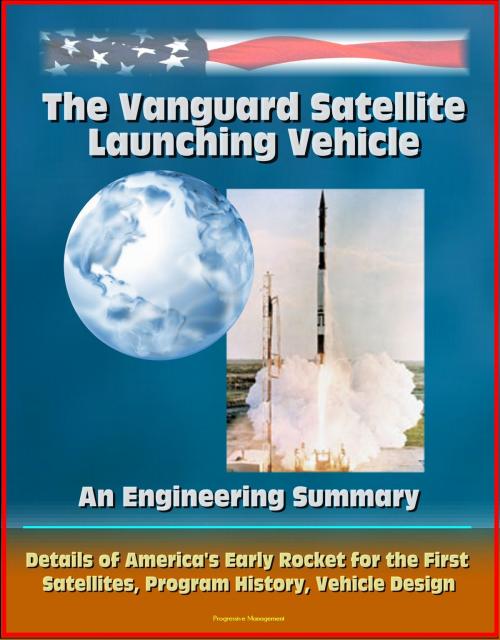The Vanguard Satellite Launching Vehicle, An Engineering Summary: Details of America's Early Rocket for the First Satellites, Program History, Vehicle Design
Nonfiction, Science & Nature, Technology, Aeronautics & Astronautics, History, Modern, 20th Century| Author: | Progressive Management | ISBN: | 9781301177547 |
| Publisher: | Progressive Management | Publication: | April 16, 2013 |
| Imprint: | Smashwords Edition | Language: | English |
| Author: | Progressive Management |
| ISBN: | 9781301177547 |
| Publisher: | Progressive Management |
| Publication: | April 16, 2013 |
| Imprint: | Smashwords Edition |
| Language: | English |
This is the official comprehensive technical report on the historic Vanguard satellite rocket. Project Vanguard was conceived in 1955 for the purpose of establishing a scientific satellite in orbit about the earth during the International Geophysical Year (July 1957 to December 1958). It was planned and implemented as a low priority, economical effort that would not interfere with military missile development. This report has been prepared by The Martin Company to summarize the engineering of the rocket vehicle that launched the Vanguard satellites. The Vanguard vehicle was a three-stage finless rocket with a liftoff weight of approximately 22,800 pounds; 88% of this weight was propellant. The first two stages were liquid-propellant rockets, guided by a "strapped-down" gyro reference system, and controlled by engine gimbaling and reaction jets. The third stage was a solid-propellant rocket motor, unguided but spin-stabilized. A jettisonable nose cone protected the payload. Launchings were made from the Atlantic Missile Range, Cape Canaveral, Florida. Unique design concepts and advanced analytical techniques were developed during the Vanguard program. Significant examples are the use of structural feedback to reduce structural loads, trajectory matching for flight analysis, and a remarkably accurate statistical approach to performance prediction. The established goal was at least one satellite orbit in six attempts. Actually, the number of attempts was increased to eleven by the use of five vehicles initially programmed for flight development testing. Three satellites were placed in orbit, containing four of the six scientific experiments originally planned for Project Vanguard. The success of the satellite launching vehicle is further manifested by the continuing use of Vanguard hardware, design concepts and analytical techniques in other advanced rocket programs.
BACKGROUND * A. State of the Art in 1955 * B. Vanguard Program Philosophy * III. VEHICLE DESIGN AND DEVELOPMENT * A. Mission Requirements * B. Trajectory Simulation * C. Staging and Flight Path Considerations * D. Performance Optimization * E. Aerodynamics * F. Structure * G. Weight Control * H. Final Vehicle Configuration * IV. SYSTEMS DESIGN AND DEVELOPMENT * A. Guidance and Control * B. First-Stage Propulsion * C. Second-Stage Propulsion * D. Third-Stage Propulsion * E. Separation * F. Ordnance * G. Electrical * H. Mechanical * I. Hydraulic * J. Range Safety * K. Instrumentation * L. Systems and Payload Integration * V. RELIABILITY * A. Requirement * B. Environmental Criteria * C. Component and System Qualification * D. Component and System Acceptance Testing * E. Vehicle Acceptance Testing * F. Reliability Follow-up * G. Observations on Reliability * VI. FIELD OPERATIONS * A. Launch Complex * B. Field Testing * C. Range Safety Considerations * D. Flight Loading and Performance Predictions * h,. Launch Operations * VII. VEHICLE FLIGHT ANALYSIS * A. Flight Summary * B. Vehicle Trajectories * C. Aerodynamics * D. Structure * VIII. SYSTEMS FLIGHT ANALYSIS * A. Guidance and Control * B. First-Stage Propulsion * C. Second-Stage Propulsion * D. Third-Stage Propulsion * E. Separation * F. Ordnance * G. Electrical * H. Mechanical * I. Hydraulic * J. Range Safety * K. Instrumentation * IX. SIGNIFICANT FLIGHT ANALYSIS TECHNIQUES * A. Philosophies * B. Techniques * X. PROGRAM ACCOMPLISHMENTS * A. Satellite Orbits * B. Mission Capabilities of the Final Vehicle * C. Advances in the State of the Art
This is the official comprehensive technical report on the historic Vanguard satellite rocket. Project Vanguard was conceived in 1955 for the purpose of establishing a scientific satellite in orbit about the earth during the International Geophysical Year (July 1957 to December 1958). It was planned and implemented as a low priority, economical effort that would not interfere with military missile development. This report has been prepared by The Martin Company to summarize the engineering of the rocket vehicle that launched the Vanguard satellites. The Vanguard vehicle was a three-stage finless rocket with a liftoff weight of approximately 22,800 pounds; 88% of this weight was propellant. The first two stages were liquid-propellant rockets, guided by a "strapped-down" gyro reference system, and controlled by engine gimbaling and reaction jets. The third stage was a solid-propellant rocket motor, unguided but spin-stabilized. A jettisonable nose cone protected the payload. Launchings were made from the Atlantic Missile Range, Cape Canaveral, Florida. Unique design concepts and advanced analytical techniques were developed during the Vanguard program. Significant examples are the use of structural feedback to reduce structural loads, trajectory matching for flight analysis, and a remarkably accurate statistical approach to performance prediction. The established goal was at least one satellite orbit in six attempts. Actually, the number of attempts was increased to eleven by the use of five vehicles initially programmed for flight development testing. Three satellites were placed in orbit, containing four of the six scientific experiments originally planned for Project Vanguard. The success of the satellite launching vehicle is further manifested by the continuing use of Vanguard hardware, design concepts and analytical techniques in other advanced rocket programs.
BACKGROUND * A. State of the Art in 1955 * B. Vanguard Program Philosophy * III. VEHICLE DESIGN AND DEVELOPMENT * A. Mission Requirements * B. Trajectory Simulation * C. Staging and Flight Path Considerations * D. Performance Optimization * E. Aerodynamics * F. Structure * G. Weight Control * H. Final Vehicle Configuration * IV. SYSTEMS DESIGN AND DEVELOPMENT * A. Guidance and Control * B. First-Stage Propulsion * C. Second-Stage Propulsion * D. Third-Stage Propulsion * E. Separation * F. Ordnance * G. Electrical * H. Mechanical * I. Hydraulic * J. Range Safety * K. Instrumentation * L. Systems and Payload Integration * V. RELIABILITY * A. Requirement * B. Environmental Criteria * C. Component and System Qualification * D. Component and System Acceptance Testing * E. Vehicle Acceptance Testing * F. Reliability Follow-up * G. Observations on Reliability * VI. FIELD OPERATIONS * A. Launch Complex * B. Field Testing * C. Range Safety Considerations * D. Flight Loading and Performance Predictions * h,. Launch Operations * VII. VEHICLE FLIGHT ANALYSIS * A. Flight Summary * B. Vehicle Trajectories * C. Aerodynamics * D. Structure * VIII. SYSTEMS FLIGHT ANALYSIS * A. Guidance and Control * B. First-Stage Propulsion * C. Second-Stage Propulsion * D. Third-Stage Propulsion * E. Separation * F. Ordnance * G. Electrical * H. Mechanical * I. Hydraulic * J. Range Safety * K. Instrumentation * IX. SIGNIFICANT FLIGHT ANALYSIS TECHNIQUES * A. Philosophies * B. Techniques * X. PROGRAM ACCOMPLISHMENTS * A. Satellite Orbits * B. Mission Capabilities of the Final Vehicle * C. Advances in the State of the Art















